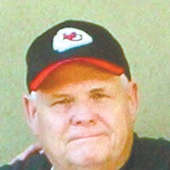Still ringing the bell for American education
The PBS Channel 26 station from Springfield recently aired a special episode about one-room schools. It was a wonderful look back into that period of our country's educational history, and it reminded me of an article I wrote back in September of 2001. (Here is a portion of that story)
In the early 1950s, my mother was still teaching in a one-room school called Longacre. Longacre was located just north of the first intersection west of Highway 71 (now I-49), on State Road BB. (At the time I wrote this story, my mother and some of her former students still held periodic reunions).
She remembered many of the names of her former students and families. The following list is just a small sampling she recalled -- Neas, Sperenkle, Hagermann, Houdeshell, Culbertson, Hornecker, Curtis, Bitner, Walker, and Rogers.
Before I was old enough to begin kindergarten, there were a few times that I was allowed to go to Longacre with my mother on a school day. I remember being very impressed with the school. It had a magical quality about it, and I was definitely "hooked" on education right then and there.
I was seated in the corner and given something to color to keep me occupied, while my mother taught her classes. At the time she was teaching students in grades one through eight. I must not have been very interested in coloring, because I spent most of my time watching those much older kids completing their studies.
My mother always claimed that the best teaching she ever accomplished was in that one room school. Her reasoning was simple. She would give the age group of first and second graders some reading work, and perhaps a writing assignment (this often included practicing their letters on those double lined worksheets).
While those kids worked on their assignments, the third and forth graders would be working on addition, subtraction, and multiplication. She would often have this group take turns going to the black board, with chalk in hand to solve math problems. (At the end of each day, one student was rewarded with the task of erasing and wiping down the black boards with a dampened cloth.)
After a time with that age group, she turned her attention to the fifth and sixth graders, whose lessons had progressed to long division and fractions. I can still see her drawing those circular pies on the black board, then dividing them into segments to give the students a visual representation of fractions.
Apparently the younger age groups were watching and absorbing these more advanced lessons too. When they returned the next year, she often discovered that they already had a grasp of the math. She felt this early observation of the more advanced age group lessons, allowed kids in those one-room schools, a type of accelerated learning.
Seventh and eighth grade classes were taught history, geography, and American Government. There were some curriculum guidelines for these schools, so that the students would be able to transfer to high school after graduating from the eighth grade.
Besides the exposure to more advanced lessons for the younger kids in those one-room schools, there was an additional advantage. She noted that the older students often helped her with lesson instructions for the younger age group classes. If a child was having a problem in one of the early grades, they did not have to wait for her to find time to help them. Older students would act much like teacher aides, and assist these youngsters.
My favorite part of the day was when she let the kids have recess and lunch breaks. Classmates played games outside when the weather allowed. At lunchtime, each child had their own lunch, which they had brought from home, as there were no school lunches provided at one-room schools.
After each recess, including the one following lunch, I got to complete my most enjoyable action of the entire day, "ringing the bell!" There may have been a larger school bell, but the one I remember was a hand bell. The highlight of my day was getting to swing that bell to notify the kids, it was time to return to class.
The one-room school was a fixture of our American History. In this new country founded upon the principals of democracy and a Constitution, mass education was considered a must by the "Founding Fathers."
Wave after wave of immigrants came to this country, and many of them had virtually no formal education. Of course they loved the freedom that America offered, but often they valued our system of public education even more. They took pride in the fact that their children would have a chance to receive an education that had not been available for them.
Over the years our family has often heard from countless former students, that our mother taught in a career that spanned more than 30 years. Time and again we hear similar remarks. "Your mom made a big impact on my life."
I know just how they feel. I had many teachers that affected my life while I was a student. As I look back now, they seem in many ways like artists. They took young minds to nurture and mold into well-rounded citizens.
I consider public education to be a right, a privilege, a duty, and most importantly, an obligation. America must never loose the concept of "education of the masses." If we ever lose that battle, we will likely lose our ability to remain a free democracy.
We must always remember our educational history, and especially those dedicated teachers in one-room schools, who taught generations of our ancestors.

